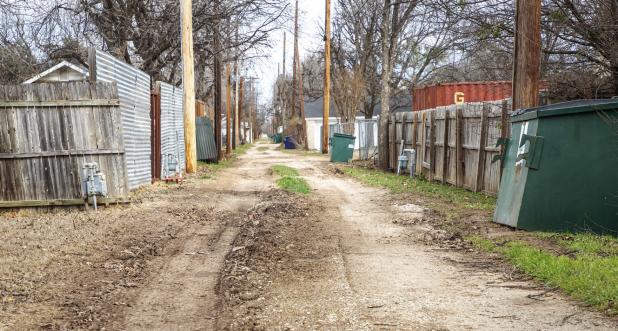
Trash talk gets poly cart pickup changed
Citizens Kathy Schrader Muncy and Johnny Moore convinced the City Council to switch pickup of their new poly carts from the alley behind their Oak Street homes to the curb - at least for the time being. The Council voted to make the move temporary while they studied the costs of repairing Olney’s rutted and narrow alleys so that Waste Connections trash trucks could pick up the poly carts without damaging fences or getting stuck.
The Council voted unanimously at its March 13 meeting to move poly cart pickup to the street “with the understanding that we’ll have a cost analysis in one month to explore the refurbish of the city alleys … and developing a more strategic roll-out plan,” Mayor Rue Rogers said. “We want to begin the process of at least exploring what it’s going to cost and looking at the alley and developing a better plan so if we do go back to the alley we are in a much better position to do that.”
The Council conceded that moving trash pickup to Olney’s streets would thrill both residents and Waste Connections, whose executives suggested just that at a public comment period last month. The City turned them down, saying the heavy trash trucks would tear up streets already in need of repaving. Mayor Rogers said the rollout had not been smooth but the City had no choice in the matter.
“Waste Connections is the one that’s saying, we’re taking your dumpsters,” Mayor Rogers said. “We were the final community that they service that still has alley dumpsters and last year we were able to negotiate and get another year. They are no longer offering that so they are forcing us to poly so we have no leverage to negotiate anymore.”
Ms. Muncy and Mr. Moore argued that there was no room in the alley behind their homes to set the poly carts four feet from any fixed object, as prescribed in the instructions they received from the City and Waste Connections when it started delivering the carts to residents about three weeks ago.
“My problem with the alley is where I’m supposed to put my cart … it’s all overgrown back there. It should be flat but because of the trucks running and the flooding, it’s all bermed [rutted],” Ms. Muncy said. “If I measure four feet from the [neighbor’s] fence, like it says in the note, it’s on the crest of the berm and the poly is not going to stand. You’ve got all the crackheads that go down that alley … no telling what’s going to be put in the trash can. I’d just as soon leave it in the front.”
The citywide switch to individual household poly carts from shared dumpsters has been universally unpopular, and the rollout has been plagued with logistical problems. Waste Connections reported that it missed more than half of the poly carts it was supposed to pick up during its latest weekly rounds, City Administrator Arpegea Pagsuberon said.
“They informed me on the last pass … there were 315 households that should have been picked up,” she said. “Only 116 of them were out [on] Oak, Payne, Elm, and Bloodworth. All those streets can be in the front because they typically don’t have alley access from their backyard. But if you are on [Avenues] E, F, G, you’re supposed to put them in the alley. Only 49 of the other 200-something were in the alley so they got missed.”
Mayor Pro Tem Tom Parker acknowledged that the City is “going to have to rebuild about a third of the alleys that are in this town.”
The City does not have the right equipment to scrape and repave the alleys but could purchase or lease equipment using federal COVID-19 funds, Ms. Pagsuberon said. That process also would mean digging up and repositioning gas and water lines in some areas, she said. “This is miles and miles of alleys so … we may want to think about … what we need to purchase to make that a realistic process,” she said.
Mr. Moore noted that the expense of preparing the alleys ultimately may not be worth the trouble. “I think you’re going to end up abandoning the alleys,” he said. “I don’t think there’s any way you can make every alley in town work. I think you end up three or four years down the road putting everything in the front.”
